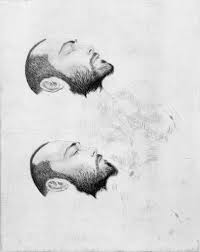I’ve recently discovered printmaking and it’s interesting to see what can be created through printing. I found nine types of printmaking in detail here, but here’s a simplified list:
- Woodcut – image is carved into wood, inked then printed, leaving reverse image.
- Linocut – similar to woodcut, but linoleum is used instead for a cleaner look.
- Etching – drawn on a wax-coated metal plate and soaked in acid, leaving wax; the paper then absorbs the image in reverse.
- Engraving – similar to etching, but etched directly onto metal plate to be inked and printed.
- Monotype – ink or paint is created on a smooth surface and finished in a reverse image.
- Lithography – most difficult method; an oil-based implement is coated with a water-based liquid, then ink is repelled by water, filling in just the image.
- Screen Print – an ink-blocking stencil is applied to a screen and when wiped, it passes through, transferring the image. (Andy Warhol’s work is an example.)
- Digital Print – Used with a computer and ink-jet printer; it’s much easier to produce multiples of a piece using this method.
- Transfer – Moves images from one source to the next using rubbing, tracing, pressing or other techniques; examples are gravestone rubbings and carbon copies.
A notable artist I watched an Art 21 video of is Kiki Smith. (Here’s the YouTube video as she works.) While printmaking isn’t her only art method, it’s this method of hers that caught my attention the most. The above image is from the video attached where she edits and prints it. The video showed how much precision and focus it takes to make sure a piece is prepared correctly. The outcome looks amazing and seems that it would be more difficult if attempted by just pencil.
Printmaking doesn’t have to be an expensive and difficult form of art. There are easy at home projects that can be done with even styrofoam. Using just a pen or pencil, you can carve a design into the foam, paint over it and use it as a stamp. The raised parts left over from the carved design will leave the design since paint will not be on them. (The original project I found was here, a post from 2011 in the Poppytalk blog.
Note: On my next post, I’ll dive into the app idea I’ve been looking into that would branch from this blog.


